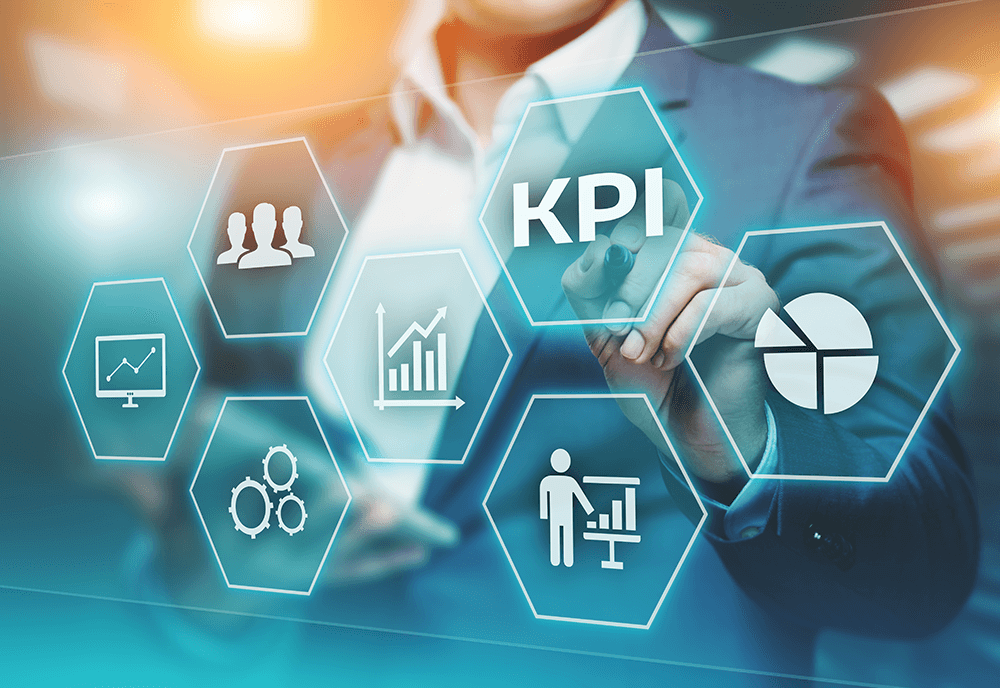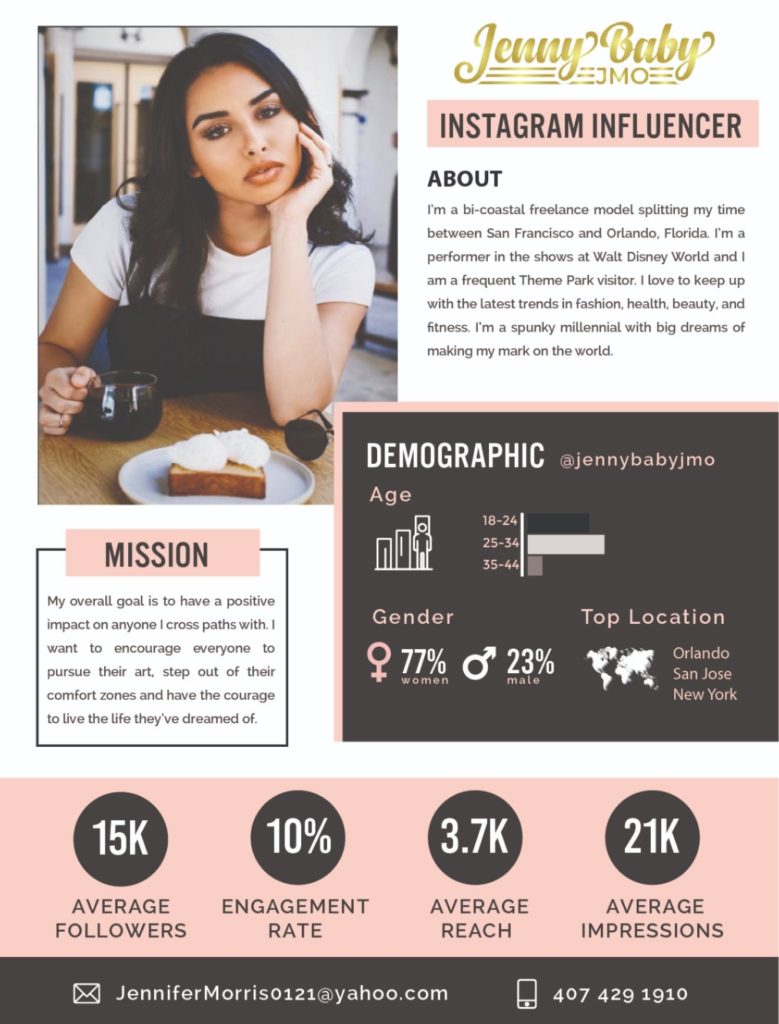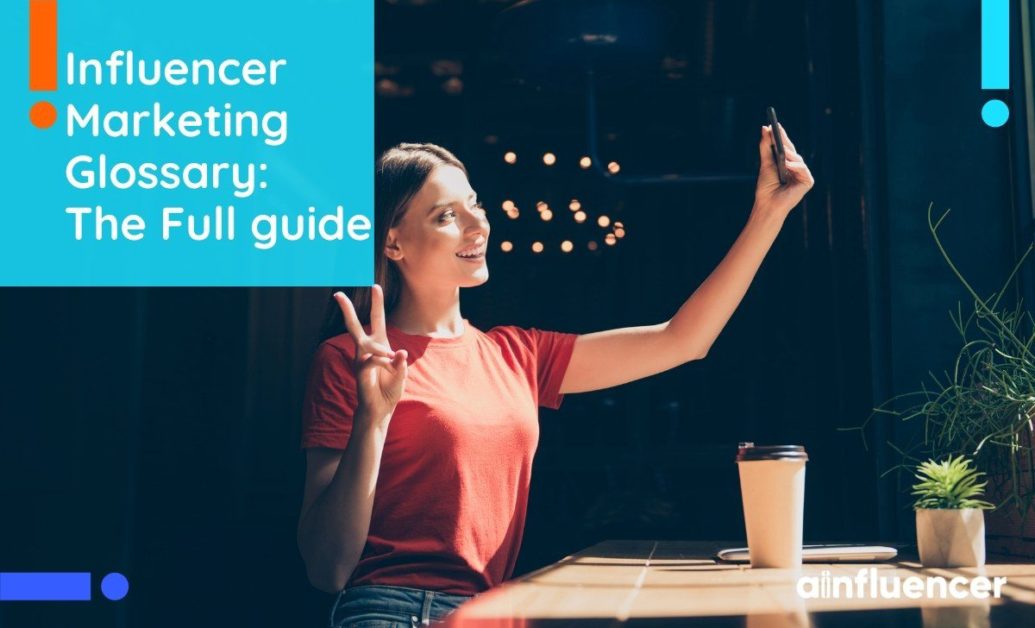In recent years, social media has made a huge impact on the way we communicate. It has also created a new way to market products and services. This is done through “influencers.” An influencer is a person who has a large following on one or more social media platforms and is able to persuade their followers to take action, such as buying a product or service.
The social media influencer marketing space has grown in the past few years, and there are now some defined terms that everyone should know to be able to speak the language of influence.
To help you out, we’ve put together some influencer terms and social media marketing terms that you need to know before executing your influencer marketing campaigns.
Influencer marketing glossary of terms

1- Affiliate marketing
One of the marketing terms you may have heard several times is affiliate marketing. Affiliate marketing is a type of performance-based marketing where a business rewards one or more affiliates for each visitor or customer brought by the affiliate’s marketing efforts. Affiliates can earn commission fees on sales, registration, or subscription fees, as well as other types of actions.
2- Ambassador
This is one of the commonly used influencer words, which means an individual who is the face of a campaign for a specified duration.
A brand ambassador is a spokesperson who is hired by a company to promote its products or services. These ambassadors can be celebrities, athletes, or other public figures. They are often paid to post about the company on social media and to attend events where they can promote the products. Brand ambassadors can be very effective in increasing brand awareness, and they can help create a positive image for the company.
3- Accounts reached
It refers to the number of unique accounts that viewed your content.
4- Audience
One of the other social media marketing terms is the audience. It refers to a group of people who follow and interact with an influencer on social media. Influencers can grow their audience and develop relationships over time by understanding and sharing authentic and compelling information. The most significant asset of an influencer is their audience.
5- Benchmark
Benchmark as one of the common influencer words, is a point of reference to which things can be measured, to determine success or failure.
Benchmarking is the process of comparing a company’s performance to others in the same industry. It can help a company identify areas where it excels and areas where it could improve. Benchmarking can also help a company set goals and measure progress over time.
There are a number of different benchmarking resources available, including databases, industry organizations, and consulting firms.
6- Brand Awareness
Brand awareness as one of the frequently used marketing terms is one of the most important aspects of any business, large or small. It is the degree to which a consumer can identify and recognize a particular brand and product.
A high level of brand awareness means that consumers are more likely to buy from you because they know who you are and what you offer. There are many ways to increase brand awareness, but it all starts with creating a strong marketing strategy.
7- Brand Advocate
Brand Advocates are the people who are most likely to talk positively about your product or service. They might post about it on social media, recommend it to friends, or even write blog posts or articles about it. Because they’re so passionate about your product, they can be a powerful marketing tool.
8- Brand engagement
Brand engagement is one of the most important aspects of effective marketing. It is the ability to create a connection with customers and keep them interested in the brand. There are many ways to engage customers, including creating loyalty programs, social media campaigns, and providing customer service. Brand engagement is essential for building customer loyalty and creating a positive brand image.
9- Call-To-Action (CTA)

CTA is one of the influencer terms in digital marketing which is a directive to the user to take a specific action. This could be clicking on a link, downloading an app, or making a purchase. CTAs are often placed in text or images to encourage users to take the desired action.
From Instagram captions (“click the link in my bio for more!”) to emails (“sign up today”), CTAs are everywhere. Influencers may be expected to employ a CTA to direct their audience to a certain website or product on behalf of the company, depending on the sort of collaboration.
10- Campaign
Campaigns as one of the other influencer terms are a collection of marketing initiatives aimed at achieving a particular goal. For example, a company might enlist your help for a campaign promoting a new product launch, with the goal of increasing product awareness and sales. Multiple influencers may be collaborating on a single campaign, or your participation may be limited to just pushing out messaging via your social media influencer platform as part of a broader effort.
11- Click-through rate (CTR)
Click-through rate (CTR) is the percentage of people who view your ad and then click on it. This metric is used to measure the effectiveness of your ad. If you want to improve your CTR, make sure your ad is relevant to your audience and that it stands out from the competition.
Influencers with high click-through rates frequently have highly engaged audiences who act on the content they promote.
12- Case study
A case study is the research and analysis of an event, project, or campaign with the goal of gaining insights from the result.
Case study research is used in many different disciplines, including psychology, social work, management, and education. However, marketing companies and social media influencer marketing professionals have recently begun to create case studies on influencer marketing activities in order to measure their performance and return on investment (ROI).
13- Content calendar
A content calendar is a document, excel sheet, phone app, or website used by businesses to plan and organize their content marketing strategy. It can be a simple spreadsheet or a more sophisticated software program. A content calendar helps you to map out your content ideas and schedule them for publication. It also allows you to track your results and measure the success of your content marketing efforts.
14- Content marketing
This social media jargon_content marketing_ is a form of marketing that involves creating and sharing content to attract and retain customers. This type of marketing can include blog posts, videos, infographics, social media posts, and more. Content marketing is a great way to connect with your target audience and build trust and credibility.
15- Conversion
This is one of the familiar influencer terms which refers to the process of turning potential customers into paying customers. It’s the difference between getting someone to visit your website and getting them to buy something. There are a lot of factors that go into conversion, from the design of your website to how you market your products. But the most important thing is to understand what your customers want and give it to them.
16- Cost-per-Acquisition (CPA)
Cost per acquisition, or cost per action, is simply the cost of a conversion. Calculated by dividing the total media investment by the number of acquisitions. E.g. $100,000 media budget / 1,000 sales = $100 Cost-Per-Acquisition.
17- Cost-per-click (CPC)
If you’re a business owner, you’ve undoubtedly heard one of the most common social media marketing terms, “cost-per-click” (CPC). CPC is a metric used to measure the money you’re spending on paid advertising.
In a nutshell, CPC is the average amount you’re paying each time someone clicks on your ad. To calculate your CPC, divide your ad budget by the total number of clicks your ad received.
18- Cost-per-lead (CPL)
The cost per lead (CPL) is the expense of acquiring a new potential client. It’s a pricing strategy in which an advertiser pays for the leads that the advertisement generates.
19- Cost-per-Engagement (CPE)
CPE is one of the influencer terms that is often used in social media to measure the effectiveness of a campaign. It is calculated by dividing the cost of the campaign by the number of engagements it generated. This metric can be used to compare different campaigns and determine which one was more effective.
20- Cost-per-Mille (CPM)
In advertising, Cost-per-Mille (CPM) is a measure of the amount of money spent to reach 1,000 people. It’s also known as “cost per thousand” or “cost per mille impressions.” In other words, CPM is the cost of an advertisement campaign divided by the number of people who see it.
To calculate CPM, you need to know two things: how much your campaign cost and how many people saw it.
21- Collaboration
In influencer marketing, collaboration takes place when an influencer and a brand work together.
22- Destination marketing organization (DMO)
A destination marketing organization (DMO) is a company or group of people that are responsible for promoting a specific destination. This can include a city, town, county, region, or country.
DMOs work to attract tourists and business travelers to their area by creating marketing campaigns and promoting the area as a travel destination. They also work to improve the infrastructure and amenities in the area so that it is more appealing to visitors.
23- Deliverables
Deliverables, as one of the influencer terms, are a critical part of any marketing campaign, and influencer marketing is no exception. When you work with influencers, you need to define what you expect them to deliver and then ensure that they understand what is expected of them. Only then can you be sure that the campaign will be successful.
24- Distribution Channel
Distribution channel as one of the social media marketing terms refers to the platform that is used to share content on.
25- Earned media
Earned media is one of the influencer words which is used in marketing and public relations to describe publicity or advertising that is not paid for by the advertiser. Earned media can be achieved through various means, such as press coverage, social media engagement, and online reviews. Many businesses strive to achieve earned media because it is seen as more credible than paid advertising.
Paid, owned, and earned media are the three categories of media. Paid media is paid advertising (think Facebook ads), owned media is all of the person’s or company’s websites (their website, Instagram, and Facebook page), and earned media is any media about the person or company that isn’t paid or owned. When it comes to getting publicity for a topic or event, PR professionals prioritize earned media. Is it possible that someone else is talking about you? That’s what we call earned media.
26- Earned Media Value
Earned media value (EMV) is a term used in marketing and public relations to describe the potential value of publicity or exposure generated through media outlets such as print, broadcast, or online news and social media. EMV is calculated by multiplying the audience size by the average advertising rate for that medium.
27- eCommerce
Ecommerce, or electronic commerce, is one of the marketing terms that refers to the buying and selling of goods and services over the internet. It has revolutionized the way businesses operate by providing a new way to reach customers around the world.
ECommerce allows customers to purchase items without leaving home, and businesses can sell products to a global market at a fraction of the cost of traditional methods.
28- Engagement
This social media jargon is used in social media and influencer marketing. Engagement is a way of measuring how involved people are with your brand or product on social media. It includes things like shares, likes, comments, and clicks. To measure engagement, you need to track three things: reach, engagement rate, and impressions.
29- Engagement rate
Engagement rate is one of the frequently used influencer terms which is a metric that social media marketers use to measure the effectiveness of their posts. It is calculated by dividing the number of interactions (likes, comments, and shares) by the number of followers a page has. Engagement rate can help social media marketers determine what content is resonating with their audience and adjust their strategy accordingly.
30- Editorial calendar
Content marketing is structured and arranged using an editorial calendar. Editorial calendars help brands and businesses plan when they’ll conceive, create, edit, and publish content for their various channels, such as their email list, website articles, social media, and even print.
It helps teams and departments stay organized with their campaigns and ensure that content is published regularly and on schedule.
31- EOD
“EOD” stands for “End of Day,” which refers to the end of a business day rather than the day itself. In investing, this term refers to the point at which all buying and selling for the day is completed. This term is also used in other industries to refer to the end of a work shift or the end of a particular stage of a process.
32- Fact sheet
A fact sheet is a document that outlines key facts, essential information, and statistics about a product, service, or business. It is typically used to provide concise information for business or marketing purposes. Fact sheets can be customized for specific audiences and used for a variety of purposes, such as public relations, product marketing, investor relations, and human resources.
A fact sheet is similar to a media kit for influencers, as it contains all of the crucial information about your blog or company that you can share with potential partners and clients!
33- FTC
FTC is an acronym for the Federal Trade Commission. It is a government agency that protects consumers from unfair or deceptive trade practices. The FTC has jurisdiction over a wide range of industries, including advertising, marketing, and sales. The agency also enforces laws against fraud and identity theft.
Influencer marketing isn’t the lawless wild west it once was! When it comes to seeing advertising and marketing on social media, the FTC is now ensuring that the consumer (your followers) is protected.
34- Follower range
In social media marketing, follower range_one of the most common influencer terms_ is the number of followers an account has on a social media platform. This number can be important for businesses because it gives them an idea of how influential their account could be. Additionally, follower range can impact other aspects of social media marketing, such as pricing and strategy.
35- Key performance indicator (KPI)

A Key Performance Indicator, or “KPI,” is a business word that refers to quantitative indications that may be used to determine whether activities or efforts are helping you achieve your overall goals and objectives. It is utilized by all sectors (and now even the influencer industry). Before starting the partnership with a brand, understand their KPIs.
Even in the influencer world, KPI is one of the well-known influencer terms that might be the number of new email signups for a brand’s email list or the number of Instagram followers for the brand’s Instagram account.
36- Impressions
This social media jargon refers to the number of times a specific content is exposed to an audience.
37- Influencer
An influencer is someone who has the ability to persuade others by virtue of their authority, knowledge, or position. They are often thought of as being experts in their field or having a large social media following. As such, they can be a powerful tool for marketing and promoting products or services.
38- Influencer Endorsement
An influencer endorsement is a form of advertising where an individual with a large social media following endorses a product or service. This type of advertising is seen as more trustworthy by consumers than traditional forms of advertising, such as TV commercials. As a result, companies are increasingly turning to influencers to promote their products and services.
39- Influencer Marketing
Influencer marketing is a form of marketing that focuses on using key influencers to drive the messaging and conversation around a product or service. Unlike other forms of digital marketing, influencer marketing relies less on ads and more on organic conversations between the brand and the influencer’s audience. This makes it a powerful tool for businesses looking to build trust and credibility with potential customers.
40- Influencer marketing platform
Influencer Marketing Platform, or IMP, is a term used to describe a technology platform that helps brands and agencies manage their relationships with social media influencers.
41- Media Kit

A media kit is one of the most talked-about influencer terms, which is a document that includes all of the important details about an influencer used when reaching out to brands for collaboration.
As an influencer, everything about you, your social media channels, your influence, statistics, demographics, partnership offerings, and contact information will be included in your media kit.
42- Memorandum of understanding (MOU)
An MOU, or memorandum of understanding, is a document that outlines the terms and conditions of an agreement between two or more parties. An MOU is not a legally binding contract, but it can serve as the basis for one. Typically, an MOU will outline the parties’ responsibilities, the duration of the agreement, and any specific provisions or goals that each party hopes to achieve.
43- Millennials
Millennials, also known as Generation Y, are typically people born between the early 1980s and late 1990s. They are often characterized as being confident, independent, and team-oriented. They grew up with technology and are used to having information at their fingertips. Millennials are also said to be more environmentally conscious than older generations.
44- Most valuable distribution (MVD)
MVD is a term used in business to describe the most valuable distribution of a product or service. The most valuable distribution is typically the one that reaches the most consumers in the shortest amount of time with the least amount of effort. There are several factors that contribute to the most valuable distribution, including cost, reach, and speed.
45- Niche
Niche is one of the influencer terms used in many different ways, but it generally refers to a specific market, audience, or topic. A niche can be an industry, such as the pet industry, or a more specific market, such as dog owners. A niche can also be a topic, such as health and fitness or fashion.
Niche marketing is the process of targeting a specific market with a specific message.
46- Power middle
Influencers that have advanced from being micro-influencers but are not yet considered social media celebrities are referred to as “power middle” influencers. In general, power medium influencers have higher engagement rates than mega influencers, and as a result, they often obtain more partnerships!
47- Outreach
Outreach means reaching out to influencers for collaborations.
48- Reach
This social media jargon is the total number of people who have been exposed to a particular piece of content on social media. It’s one of the most important metrics to measure the success of your social media campaign.
If you’re an Instagram influencer, for example, your “reach” could be the number of followers you have, Story views, or even post impressions.
The higher your reach, the more people you can potentially reach with your message. There are a number of factors that influence reach, including the type of content you share, the platform you use, and your target audience.
49- Product Integration
Integration of a brand’s specific product into influencer content by directly introducing, including, and mentioning it.
50- Press kit
In the influencer industry, the terms “press kit” and “media kit” are frequently interchanged. For more information, see the definition of “media kit” above.
51- Return on Investment (ROI)
In business, one of the most important concepts to understand is return on investment, or ROI. Simply put, ROI is a measure of how effective a company’s investments are in generating profits. To calculate ROI, you divide the profits generated by the investment amount. This gives you a percentage that tells you how profitable your investment is.
52- Return on influence
As one of the frequently used influencer words in the world of influencer marketing return on influence is a more qualitative method of determining whether you’re a worthwhile investment for a brand that might pay you for your reach.
Return on influence is more concerned with audience engagement, resonance, loyalty, and advocacy than with monetary considerations.
53- Search engine optimization (SEO)
SEO is the process of optimizing a website for Google search with the goal of earning higher web traffic levels and improving the visibility of the site. The main aim of SEO is to improve the ranking of a website on search engine results pages (SERP).
A higher ranking is a certain way to increase the number of people who view your content, which may lead to more social media followers, affiliate sales, and even the proof you need to land brand collaborations!
54- Sentiment
Sentiment as one of the most talked-about social media marketing terms is the attitude or emotional reaction that someone has toward something (in this case brands, products, and services), and companies are now using sentiment analysis to understand how people feel about their brand and what is being said about them on social media. Companies utilize social media influencer marketing to help increase sentiment among their audience as well as their brand perception online.
55- User-Generated Content (UGC)

UGC is any type of content that is developed and shared by consumers or users in an organic way. An influencer marketing campaign may be designed to encourage brand followers and consumers to share the brand’s content.









